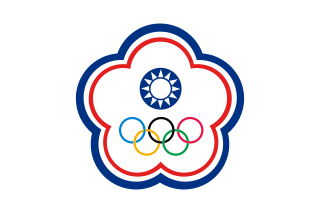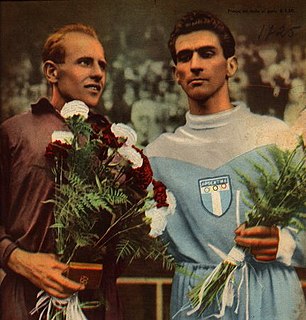
The 1952 Summer Olympics, officially known as the Games of the XV Olympiad and commonly known as Helsinki 1952, were an international multi-sport event held from 19 July to 3 August 1952 in Helsinki, Finland.

Venezuela competed at the 1952 Summer Olympics held in Helsinki, Finland. The Venezuelan Olympic Committee selected 38 competitors, 36 men and two women, to take part in 37 events across eight sports. This was a much greater turnout than 1948, Venezuela's only previous entry, which had only one athlete. For the first time, women represented Venezuela at the Summer Olympics. Women have been absent in the Venezuelan team on four occasions, including the next Summer Games held in Melbourne.

Venezuela competed at the 1956 Summer Olympics held in Melbourne, Australia, and in the equestrian events held in Stockholm, Sweden. Twenty-two competitors, all men, were selected by the Venezuelan Olympic Committee to take part in sixteen events across five sports. The delegation featured no female competitors, for the second time, and won no medals. While most of the Venezuelan athletes did not advance past the qualifying rounds of their sports, there were some good placings in the shooting, with Germán Briceño and Carlos Monteverde finishing in the top 10 of their events.

The Netherlands Antilles competed in the Summer Olympic Games for the first time at the 1952 Summer Olympics in Helsinki, Finland. The Caribbean nation, then a colonial territory of the Netherlands, was represented by their association football team.

The men's 3 metre springboard, also reported as springboard diving, was one of four diving events on the Diving at the 1952 Summer Olympics programme.

The men's 10 metre platform, also reported as high diving, was one of four diving events on the Diving at the 1952 Summer Olympics programme.

Taiwan, officially the Republic of China (ROC), currently competes as "Chinese Taipei" (TPE) at the Olympic Games. The Republic of China, representing all pre-war China, participated at the Summer Olympic Games in 1932 and 1936, and, representing all of China including Taiwan, participated in the 1948 Summer Olympics. After the Chinese Civil War the ROC retreated to the island of Taiwan and only Taiwan-based athletes have competed in its team since then. Athletes of Taiwan participated at the Summer Olympic Games in 1956, 1960, 1964, 1968 and 1972 as Republic of China (ROC). The ROC boycotted the Summer Olympic Games in 1976 and 1980 until it returned to the 1984 Winter Games, and started participating as Chinese Taipei (TPE).
The women's 200 metre breaststroke event, included in the swimming competition at the 1980 Summer Olympics, took place on July 23, at the Swimming Pool at the Olimpiysky Sports Complex in Moscow, Soviet Union. In this event, swimmers covered four lengths of the 50-metre (160 ft) Olympic-sized pool employing the breaststroke. It was the thirteenth appearance of the event, which first appeared at the 1924 Summer Olympics in Paris. A total of 25 competitors from 18 nations participated in the event.

The People's Republic of China (PRC) sent a delegation to the Olympic Games for the first time at the 1952 Summer Olympics in Helsinki, Finland.
Wu Chuanyu was an Indonesian-born Chinese swimmer who competed in the Olympic Games in 1948 and 1952. In his second Games, he became the first competitor for the People's Republic of China in Olympic history.

The women's 200 metre breaststroke event at the 1936 Summer Olympics, took place from 8 to 11 August, at the Olympiapark Schwimmstadion Berlin. It was the fourth appearance of the event, which first appeared at the 1924 Summer Olympics in Paris. A total of 23 competitors from 12 nations participated in the event.

The women's 200 metre breaststroke event, included in the swimming competition at the 1948 Summer Olympics, took place from 30 July to 3 August at the Empire Pool. In this event, swimmers covered four lengths of the 50-metre (160 ft) Olympic-sized pool employing the breaststroke. It was the fifth appearance of the event, which first appeared at the 1924 Summer Olympics in Paris. It was also the first appearance of the event since the outbreak of World War II. A total of 22 competitors from 14 nations participated in the event.
The women's 400 metre freestyle event at the 1952 Olympic Games took place between 31 July and 2 August at the Swimming Stadium. This swimming event used freestyle swimming, which means that the method of the stroke is not regulated. Nearly all swimmers use the front crawl or a variant of that stroke. Because an Olympic size swimming pool is 50 metres long, this race consisted of sixteen lengths of the pool.
The women's 200 metre breaststroke event, included in the swimming competition at the 1956 Summer Olympics, took place on November 29–30, at the Swimming and Diving Stadium. In this event, swimmers covered four lengths of the 50-metre (160 ft) Olympic-sized pool employing the breaststroke. It was the seventh appearance of the event, which first appeared at the 1924 Summer Olympics in Paris. A total of 14 competitors from 10 nations participated in the event. This was a decrease from the 1952 Summer Olympics, because the breaststroke event was split into the 200m orthodox breaststroke and the 100m butterfly event.
The women's 200 metre breaststroke event, included in the swimming competition at the 1960 Summer Olympics, took place on August 26–27, at the Stadio Olimpico del Nuoto. In this event, swimmers covered four lengths of the 50-metre (160 ft) Olympic-sized pool employing the breaststroke. It was the eighth appearance of the event, which first appeared at the 1924 Summer Olympics in Paris. A total of 30 competitors from 19 nations participated in the event. British gold-medalist Anita Lonsbrough became the first swimmer to break the world record in this event, with a time of 2:49.5 in the final.

The women's 200 metre breaststroke event, included in the swimming competition at the 1964 Summer Olympics, took place on 11–12 October, at the Yoyogi National Gymnasium. In this event, swimmers covered four lengths of the 50-metre (160 ft) Olympic-sized pool employing the breaststroke. It was the ninth appearance of the event, which first appeared at the 1924 Summer Olympics in Paris. A total of 27 competitors from 15 nations participated in the event. Soviet Union's Galina Prozumenshchikova and Svetlana Babanina won their country's first ever medals in this event, with a gold and bronze medal respectively. Claudia Kolb's silver medal was the United States' second ever medal in this event, after Agnes Geraghty's silver in the inaugural event in 1924. In the heats, Australian Christine Barnetson was disqualified for an incorrect breaststroke, and Hungarian Márta Egerváry withdrew from the competition.
The women's 200 metre breaststroke event, included in the swimming competition at the 1968 Summer Olympics, took place on October 22–23, at the Alberca Olímpica Francisco Márquez. In this event, swimmers covered four lengths of the 50-metre (160 ft) Olympic-sized pool employing the breaststroke. It was the tenth appearance of the event, which first appeared at the 1924 Summer Olympics in Paris. A total of 31 competitors from 20 nations participated in the event. American Catie Ball was the large favourite to win the event, as she had broken the world record in this event the last three times. However, she was suffering from a virus infection and was forced to withdraw from the heats. Her 16-year-old teammate Sharon Wichman won the event, breaking bronze medalist Galina Prozumenshchikova's Olympic record in the final.
The women's 200 metre breaststroke event, included in the swimming competition at the 1972 Summer Olympics, took place on August 29, at the Olympia Schwimmhalle. In this event, swimmers covered four lengths of the 50-metre (160 ft) Olympic-sized pool employing the breaststroke. It was the eleventh appearance of the event, which first appeared at the 1924 Summer Olympics in Paris. A total of 40 competitors from 23 nations participated in the event, another 2 entries from 2 other countries did not compete.

The marathon at the 1952 Summer Olympics was held on 27 July on a course running from the Helsinki Olympic Stadium to Korso, Helsinki Rural Municipality and back. Sixty-six athletes from 32 nations competed. The maximum number of athletes per nation had been set at 3 since the 1930 Olympic Congress.
Parsons Nabiula was a Filipino swimmer. He competed in two events at the 1956 Summer Olympics.












